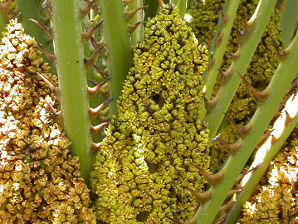Xeriscape Landscape Plants & Flowers
For The Arizona Desert Environment.
Pictures, Photos, Images, Descriptions, & Reviews.
Mediterranean Fan Palm, Chamaerops humilis.
We Are Proud Of Our SafeSurf Rating!
Click On Any Of The Following Links By Amazon.Com
To View Tools For Desert or Arizona Gardening. No Obligation!
 |
| Mediterranean Fan Palm, Chamaerops humilis. Arrowhead Ranch, Glendale, Az. January 21, 2006. |
|---|
 |  |
| Mediterranean Fan Palm. Fan Shaped Leaves | Mediterranean Fan Palm. Flower Clump |
|---|---|
 | |
| Mediterranean Fan Palm. Yellow Flowers | Mediterranean Fan Palm. Yellow Flowers |
 |  |
| Mediterranean Fan Palm. Non-Edible Fruit | Mediterranean Fan Palm. Fruit Close Up! |
Mediterranean Fan Palm.
We wish to thank Wikipedia, the free encyclopedia for some of the information on this page. We share images and information with Wikipedia. An attractive little evergreen palm that has become very popular in recent years, mostly due to its cold hardiness, it can resist temperatures below twenty degrees Fahrenheit, it is fast growing, and drought resistant too! The European fan palm forms clumps than can grow up to 15 feet in height. The triangular, fan-shaped leaves grow to about 20 - 24 inches long by about 24 inches wide. They are deeply divided into many segments that are themselves split at the tip and are supported on 3 - 4 foot stems. This is an extremely variable plant , the leaves range from blue-green to grey-green to yellow-green. Some plants form suckers to become very shrubby plants that may reach 15 feet in width. Other individuals can be seen that are dwarf in size, growing about 5 feet tall by 4 feet wide. It is best to remove all but a few of the suckers and to prune the leaves to form a cluster of clear-trunked "smaller" palms. The Mediterranean Fan Palm has small, bright yellow flowers that form close to the trunk hidden behind the leaf stems which are armed with very sharp teeth. These are followed in the fall by a seedy fruit which is dark yellow, orange or brown about 1 inch in diameter. This plant is native to the hot, dry hills and mountains of the Mediterranean Sea basin. Its native range extends from Africa's Atlas Mountains in Morroco to Spain and France and eastward to Turkey. To be more specific,this plant can be found all over the western Mediterranean, from the south of Portugal to Malta, and from Morocco to Libya, appearing mainly on the coast, but also up to 6,562 feet, on the Great Atlas mountain range of the African continent. It grows wild in the Balearic Islands and in the Iberian Peninsula, from the Costa Brava in Gerona to Cape San Vicente and Setubal in the south of Portugal, and can be found along the coastal fringe, on cliffs above the sea, on hillsides and in gorges, at altitudes normally below 3,281 feet. Palmitos grow on the fertile plaines of the Guadalquivir, as far inland as the province of Jaen. With the leaves trimmed up to clear the trunk it makes a beautiful specimen plant - a delightful natural sculpture to grace your patio or entryway. Unpruned, they assume an attractive shrubby form. Use them as a screens or plant several side by side to form barriers. The European fan palm is excellent in containers and urns. And thanks to it's drought resistance and durability to heat it can thrive in harsh Arizona urban conditions. An excellent xeriscape garden plant.
Quick Notes:
Height: About 5 - 15 feet tall, spread (crown) 5 - 20 feet.
Flowers: Its flowers, unisexual on dioecious plants, are small, whitish, fragrant, clustered in axillary spadices up to 120 cm long markedly bent downwards by their fruit weight.
Flowering Time: Southern Arizona, March - April. Phoenix Area, April - May.
Fruit & Seeds: The fruits, commonly known as non edible dates, are on the terminal portion of trunk, in clusters of small, 1 inch round to oval reddish brown fruit.
Stems/Trunks: White thorns of varying length; typically 1/4 to 1in long and white; thorns are most obvious on young trees, fewer found on mature specimens; young stem growth has reddish color, turning brown to gray-brown and becoming furrowed and scaly.
Leaves: The leaves are fan with a narrow petiole; there are sharp teeth on the petiole; the frond color may vary, from gray to dark or yellow green.
Found: Native to the Mediterranean (Europe and North Africa) . Found throughout Arizona landscaping at lower elevations.
Hardiness:
Soil pH requirements:
Sun Exposure:
Elevation: Usually at 0 - 5,900 Feet.
Habitat: Lower elevations where water is available. It grows well in sand, sandy loam, clay and other heavy soils. It needs good drainage and aeration. It is remarkably tolerant of alkali.
Miscellaneous: Flowering Photos Taken At Glendale, Arizona. January 21, 2006. Maintenance: Low. Pool friendly.
|
We Are Proud Of Our SafeSurf Rating!
Click On Any Of The Following Links By Amazon.Com
To View Tools For Desert or Arizona Gardening. No Obligation!
Click On Any Of The Following Links By Amazon.Com
For Books, & Videos About Xerioscape Plants Of Arizona & The Southwest USA. No Obligation!



| © 1966 - Present, Audrey, Eve, & George DeLange |





